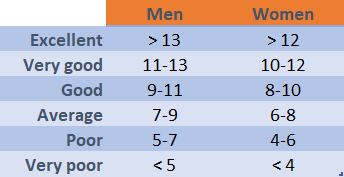

The score can also be converted to a VO2max score, using this table or calculator. India vs South Africa, 3rd Test, Day 2: Jasprit Bumrah was in top form and registered his seventh five-wicket haul and was well supported by his sides other bowlers. You can use our fitness rating tables to get a rating based on your result. The timings for the test is not simple (see table), and to conduct the beep test you need an audio recording of the test (some buying advice here). We have clear instructions for conducting the test. The beep test was developed primarily for children and team sport players, though is becoming a popular test for athletes of all ages, sports and levels. There are a few versions of the beep test, as well as modified tests and alternatives to the beep test. The test continues until the participants are no longer able to keep up with the required pace. At regular intervals, the required running speed increases. To dominate the Beep Test you will need to run over 18km/hr.

There are several versions of the test, but one commonly used. The time between recorded beeps decrease each minute (level). The tables below give a general fitness rating based on the beep test score. This test involves continuous running between two lines 20 meters apart in time to recorded beeps. You may have completed the beep test and received a score, but the numbers may not mean anything without a reference point to make sense of the results.Normative tables (norms) are very useful to help guide you in the interpretation of the test results.
Soccer beep test download#
At the early stages you need to run under a comfortable 9km/hr. Beep Test For this test, you need to download the Beep Test or purchase the CD. In general the Beep Tests increases by 0.5km/hr with every level. So with every level the speed you need to travel between the shuttles is faster. The Beep Test involves running between two markers 20 meters apart, following audio cues which dictate the running speed required. With every level the Beep Test beeps get closer together. It is often used as the preferred option to monitor progress in response to physical activity programs because of the low cost of equipment, and its ability to test large groups of participants simultaneously. The test was developed in the 1970s by the French Canadian Luc Léger and his colleagues, and is now one of the most commonly conducted aerobic fitness test around the world. The Beep Test is a maximum aerobic endurance fitness test, involving running between markers placed 20 meters apart, at increasing speeds, until exhaustion.


 0 kommentar(er)
0 kommentar(er)
